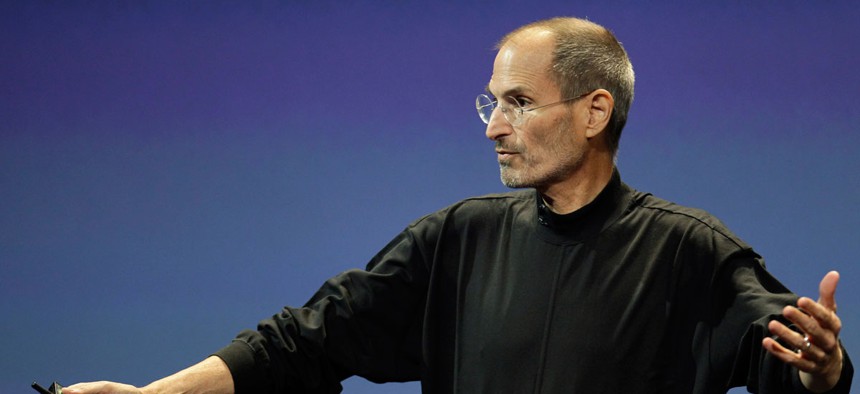
Jobs speaks at the iPhone 4 event in 2010. Paul Sakuma/AP
Why Steve Jobs’s Influence is Reverberating Through Government
We’re witnessing a second American Revolution, where government is being radically re-shaped by data-driven digital innovators.
One of the newest, hottest and most visible career paths right now is the westward exodus of talented investment bankers from Wall Street to Silicon Valley.
But, if you look closely, this vaunted professional migration has been offset in recent months by an equally powerful influx of cutting-edge technology executives, who have flown East to Washington DC in order to help transform the US government into an innovative and 21st century data-driven digital entity.
For example, D.J. Patil, an engineer and entrepreneur who helped create Silicon Valley’s original data science team at LinkedIn, has been named the nation’s first chief data scientist; Megan Smith, a former vice president at Google, is now the chief technology officer of the United States; Jason Goldman, a Twitter veteran, has become the White House’s first-ever chief digital officer (CDO); and David Recordon, previously an engineering director at Facebook, will serve as the director of White House information technology. From my own company, Socrata, our former director of open data, Ian Kalin, has returned to public service as chief data officer at the Department of Commerce.
The fact that this tsunami of technology talent has washed over Washington is no coincidence.
Governments around the world are rapidly mobilizing to embrace the digital age because of intense constituent pressure to open, curate, network and deploy public data for new initiatives that will increase public sector transparency, accountability, cost savings and operational performance efficiency.
Indeed, mounting evidence indicates that when governments open raw public data to citizens and application developers; present government performance data for mass public consumption; and proactively pursue and promote a new generation of digital-first and data-driven services, there is a surge in citizen–and voter–satisfaction.
This helps explain why 80% of public sector respondents in Socrata’s 2014 Open Data Benchmark Report said that their investment and spending on open data programs will be consistent or increase in the next six months.
It also bolsters the findings of a Government Technology survey, which indicated that open government, transparency and open data is the top priority of CIO’s in cities.
And it reinforces the significance of a McKinsey analysis–Public Sector Digitization: The Trillion Dollar Challenge–which suggests that capturing the full potential of government digitization could free up to $1 trillion annually in economic value worldwide, through improved cost and operational performance.
On a more micro level, a city like San Francisco, for instance, reports that citizen access to real-time transit data resulted in 21.7% fewer SF 311 calls, which yielded savings of over $1 million a year. And, in Texas, the comptroller’s office used its transparency Web site to save $4.8 million from more efficient administration in the first two years after the site was launched.
At its heart, the public sector’s mission-critical “digital first” efforts are based on the very real and powerful idea that data is an invaluable strategic asset and a critical new natural resource for government in the 21st century.
The new drive to digitize also says that digital infrastructure is now every bit as important as the physical infrastructure of government, which has been growing larger in the United States since the 1930’s. In addition, it says that citizen services and interactions are increasingly about the flow of digital information and transactions–fewer and fewer people are actually going down to City Hall to conduct their business with government these days. And, finally, it’s part of a related public sector move toward data-driven digital solutions, whether it’s body cameras for police or online health care insurance.
In basic technology terms, the new digital-based government of the 21st century incorporates and deploys a host of critical, adaptive, effective and lower-cost architectures, platforms, solutions, applications and services–from mobile communications, cloud computing and software-as-a-service to open data, predictive analytics and online voting.
These recent technology solutions are being developed exclusively for government data; they aren’t part of cumbersome, expensive and retrofitted corporate systems, which, in the past, have failed to serve the public sector’s specific needs in an effective or efficient way.
Instead, the new digital and data-driven tools for the public sector are becoming more and more consumer-friendly. They have to be, because governments everywhere are catching on to the fact that a new digital-age “normal” has emerged, thanks to the unprecedented onslaught of brave new ideas and disruptive technologies from innovative companies like Apple, Amazon, Twitter, Google, Facebook, Uber, Coursera and airbnb–to name just a few.
Citizens around the world have been using these breakthrough digital products and services for years, and so they expect government technology to look, feel and perform similarly.
Unfortunately, it’s not always easy to meet mass consumer expectations when it comes to the Internet and its ability to deliver a real-time information experience. Wherever you look, governments are having a hard time keeping up with technology-driven citizen mobilization–in large part, because they lack state-of-the-art digital infrastructure or capabilities. As a result, a number of public sector organizations are losing relevancy and legitimacy in the public’s eyes.
So, to better connect with constituents, scores of governments are currently re-thinking and re-designing the technology experience that they’ve been providing for years.
Mirroring some of the most widely adopted, consumer-friendly technologies in the world, the new approach puts people front and center and makes sure the information they need is readily available, totally approachable and completely digestible.
In the process of this far-reaching government transformation, we’re seeing millions of dollars worth of outdated and outmoded legacy technology get swept away in favor of the latest digital solutions.
“The burden of legacy technologies in government puts innovation on a path of incremental improvement when agility and quick solution delivery is expected,” explains Rick Howard, Research Director at Gartner in a recent analysis, Legacy technologies burden government CIOs. “It’s all about starting with the digital world and what is possible”
To explore and implement what’s possible, government leaders like President Obama are hiring some of the best and brightest digital innovators from Silicon Valley.
This isn’t the only model for digital success in the public sector, however.
In Los Angeles, for example, Mayor Eric Garcetti has appointed Abhi Nemani as the city’s first Chief Data Officer. A 2010 graduate of Claremont McKenna College who is a self-proclaimed “technological optimist,” Nemani works with city departments to collect and analyze data, and he also leads the operation of Los Angeles’ new open-data portal.
Los Angeles also has Ron Galperin, one of the most tech-savvy city controllers in the nation. Galperin is in the process of releasing just about every piece of financial data in order to unlock the mysteries of the city’s $8 billion treasury for residents.
Citing Article 1, Section 9, Clause 7 of the U.S. Constitution–which says that “a regular Statement and Account of the Receipts and Expenditures of all public Money shall be published from time to time”–Galperin clearly sees his digital mission as part of the bequest handed down by the Founding Fathers.
As we look towards the future, it’s becoming increasingly clear that we’re currently witnessing a second American Revolution; but this time the government is being radically re-shaped by data-driven digital innovators who channel the thinking of Steve Jobs rather than patriotically-driven lawyers who accessed the philosophy of the Enlightenment.
NEXT STORY: Three Ways to Stop Judging Yourself







